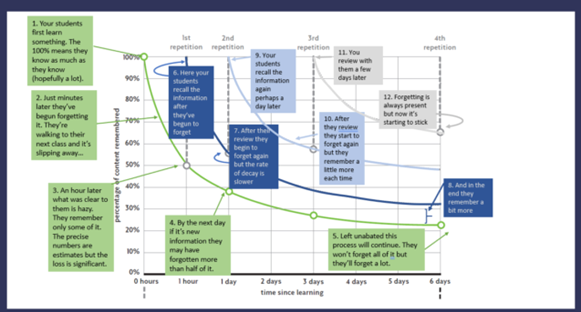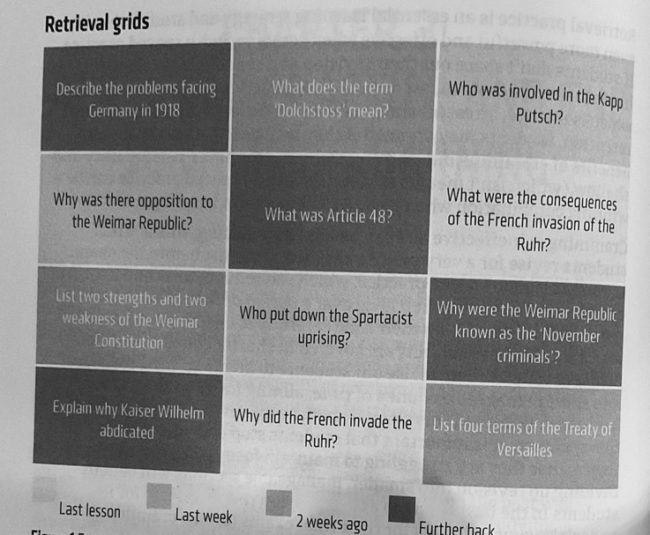08.11.21Hernandez: The Time is Now for Understanding Learning, Forgetting & Retrieval Practice

After eighteen months, schools are at last welcoming students back to classrooms. But even as it feels like we’re approaching some semblance of classroom normalcy, questions about how we can help students catch up academically after a year of virtual/hybrid instruction loom large. Although it can be hard to precisely quantify the academic impact of this past school year, a recent report published by Curriculum Associates and McKinsey & Co. estimates that students in grades 1-6 are returning to classrooms an average of five months behind in math and four months in reading. Even more troubling is that the academic effects of this past year have been inequitable, leaving students of color and from low-income households even further behind than their white and more affluent peers.
Although there’s no silver bullet solution, we think a smart bet is to look to cognitive science to guide us. Over the past 25 years, cognitive science has revolutionized our understanding of how students learn, but much of that research hasn’t influenced teachers’ practice. In fact, one common definition of “learning,” that some cognitive scientists use is, “a change in long-term memory.” That’s a provocative definition. Part of us resists it. It has to be more than that. But it that pushes us to understand some of the gaps in how we teach. If students understand something during a lesson, but not a few days later, it’s hard to argue they’ve truly learned it.
In the following post, I’ll unpack snippets from Doug Lemov’s forthcoming Teach Like A Champion 3.0, which offers practical advice on how teachers can implement one of the most potent research-backed tools for improving student learning: Retrieval Practice.
–Joaquin Hernandez
Why Forgetting is So Key to Learning
In Teach Like A Champion 3.0, Doug begins his chapter on Retrieval Practice by describing a scene from the life of every teacher:
On Tuesday you are confident in your students’ skill and knowledge. They’re solid on the what, why, and how. But when you assess them a week and a half later, it’s as if Tuesday’s lesson never happened. Then, Rodrigo completed five complex area problems with ease; now you glance over his shoulder and see that he has gotten even simpler problems wrong.
As educators, we’ve all felt the disappointment of this moment. But as Doug points out, ironically there’s a silver lining to this endemic challenge:
“The process of forgetting contains the seeds of its own solution. If you ask students to recall what they learned yesterday about the area of polygons or juxtaposition in Romeo and Juliet they will strain to remember but if successful, that struggle will more deeply encode the material in their long-term memories. They will remember a little more and forget a little less quickly.”
What Doug’s reflections help illustrate is how it can often feel like we’re fighting a losing battle against forgetting. But cognitive science suggests there are tools that can both interrupt and guard against this. One of the most powerful of these is Retrieval Practice, a research-backed practice that Doug defines as “the process of causing students to recall information they’ve learned after a strategic delay.” As teachers, we use Retrieval Practice whenever we ask students to pull information from long–term memory. On this practice, the science is unequivocal: the simple act of retrieving helps students remember more, for longer, and with greater accuracy. Every time we ask students to retrieve, we make it easier for them to recall this this knowledge when they need it, strengthen its connections to previous learning, and apply it in different contexts
When I first heard about Retrieval Practice, I thought it sounded like a fancy term for something teachers already do: asking students to recall stuff they learned. As it turns out, the apparent banality of this practice is part of its power. Although it’s a common practice in classrooms, many of are using it at a fraction of its potential. With a few simple, evidence-based tweaks, we can amplify the positive effects of Retrieval Practice on our students’ learning.
To help illustrate how forgetting works, and the role Retrieval Practice can play in interrupting it, Doug includes a graph of Hermann Ebbinghaus’s forgetting curve (which he later annotated blogged about here). As Doug explains:
“If you graphed the process of retrieval practice it might look something like this, with each repetition along the top axis an iteration of retrieval practice and the percentages on the y-axis representing how much of a given body of content students remember.”

See it in Action: Retrieval Practice
To show what this technique looks like in action, Doug points us to the first half of this Keystone video from Christine Torres, an ELA teacher from Springfield Prep. In it, we see Christine asking students to engage in Retrieval Practice of some key terms they just learned.
Christine’s textbook implementation of Retrieval Practice illustrates many of the principles that are borne out by the research. Here are just a few:
- After a Brief Delay. Christine understands that the best time to retrieve something is once you’ve begun to forget it. Since forgetting starts right away, she doesn’t wait long before she initiates some Retrieval Practice. They start retrieving the content shortly after they’ve learned it. And as Doug notes: “Christine will be sure to follow up the next day and/or a few days later—and again a few days after that—with more fun and engaging questions to retrieve and apply their knowledge of their vocabulary words.”
- Full Engagement: Christine makes sure that every student wrestles with almost every question. She uses Turn and Talks (see technique 42). For retrieval, we can’t just take hands from volunteers or let a few highly verbal kids call out answers. We need to cause everyone to retrieve and apply newly learned knowledge.
- Low Stakes. Christine’s Retrieval Practice is truly practice. Students aren’t graded for accuracy or shamed for forgetting. This allows students to focus on recalling and applying the knowledge, not measured on what they have learned. Engaging students regularly in Retrieval Practice, with multiple (ungraded) at-bats makes it feel low stakes. Frequent Retrieval Practice builds students comfort with forgetting and their confidence when they get it right.
- Meaning-Centered. As Dan Willingham notes in his outstanding 3rd edition of Why Students Don’t Like School, students remember more of what they are learning if they are required to think about meaning. Christine does a beautiful job of demonstrating this by asking students to respond to questions that cause them to consider different shades of meaning for key words with depth and richness.
- Immediate Feedback. Students immediately receive feedback for their responses. This is powerful in two ways: first, it clarifies demonstrate appropriate use of the vocabulary and which don’t, ensuring students encode the former and not the latter; second, it lets students know what they know and don’t know yet, allowing them to make smarter decisions about what to prioritize when studying and practicing.
- Routine. In Christine’s class, students routinely engage in Retrieval Practice after they learn new vocabulary. They know practice is coming, so there’s no “gotcha” when she calls on students to share answers. What’s more, Retrieval Practice—and the knowledge this helps students encode—has compounding effects over time. The more regularly you ask students to retrieve what the learn, the more deeply students encode what they in memory. Over time, this allows Christine’s students to acquire more knowledge faster, accelerating her students’ gains in learning and their ability to make meaning from complex texts.
Christine’s Retrieval Practice also helps dispel a common misconception, which is that it’s only about “rote memorization” and “simple recall.” As Doug writes:
“Notice the richness of the questions Christine asks…Christine asks her students to apply the vocabulary words they’re learning in different ways and new settings. That’s important because words work differently in different settings. To truly understand a word, you’d want students to constantly encounter it in all its nuanced shades of meaning. Christine asks students to know the definition, but also to apply the word in challenging and interesting ways. It’s both simple and more elaborated retrieval.”
With that said, there’s still tremendous power in simple recall. In fact, the memorization of seemingly trivial facts provide the building blocks that are needed for critical thinking and creativity. Practice strengthens neuronal connections and cements learning, providing students with a “springboard” to the holy grails of teaching: critical thinking and creativity.
Other Methods of Retrieval Practice
A common misconception is that Retrieval Practice always looks like oral drill or a written quiz followed by feedback. In fact, retrieval occurs whenever students engage in any activity that cause them to retrieve something from long-term memory. Common methods include: studying with flashcards, answering checks for understanding, engaging in a Turn and Talk, stop and jots, weekly cumulative quizzes, retrieve-taking (interspersing lecture with pause points so students can take notes on what they just learned), and brain dumps (where students write down everything they can recall about a topic). Whatever methods you use, a helpful tip is to vary them. Practicing in different ways increases the odds that students’ will be able to transfer what they learn to new contexts.
Although it’s important to be mindful which activities DO qualify as Retrieval Practice, it’s at least as important to be able to differentiate them from those that don’t. For instance, rereading a passage, or looking back at one’s notes is not considered Retrieval Practice. True retrieval should be “closed book.” Simply rereading, highlighting, or looking back at a resource does will not encode new knowledge into long-term memory. It merely shows how well students can immediately recall something they just read from working memory. Effective retrieval should be effortful; it’s the struggle that comes with trying to recall something—without the help of a memory aid—that results in learning that lasts. It’s also ineffective to have students retrieve knowledge in the absence of feedback. The risk here is that students could practice doing it wrong, encoding failure and strengthening their ability to retrieve and replicate it.
Using “Spacing” to Enhance Retrieval Practice
One of the most powerful ways we can enhance Retrieval Practice is by spacing it out over time. After a bout of learning, neuroscientists have found that the brain needs time—hours or even days—to consolidate and cement this new knowledge in long-term memory. What’s more, with each round of retrieval, students remember information for longer, which means students can go for longer between each round of retrieval. As Dan Willingham notes in his 3rd edition of Why Don’t Students Like School?, spacing can help students learn something with less practice than if they tried to bunch together their practice. In other words, spacing can help you save instructional time and even accelerate student learning.
It also helps to build retrieval into your lessons so it becomes a routine part of your class. Make it regular part of your lesson cycle, incorporating it into such activities like the Do Now, independent practice (interleaving is ideal here!), or even in homework. Although there’s no “right” way to do this, we’d like to share a sampling of suggestions from educators we admire:
- From Peps McCrea’s Memorable Teaching: “Make every third question in a problem set on a previous topic. Build regular cumulative quizzes into your teaching.” (page 83)
- From Uncommon Sense Teaching (by Dr. Barbara Oakley, Beth Rogowsky, and Terrence J. Sejnowski): “Make every two problems on your homework from today’s lesson, two problems from the previous lesson, and two problems from earlier in the unit.” (page 153).
- Inspired by Alex Laney: In 2017, Alex Laney shared some beautifully designed Do Nows, which sparked our team’s thinking about how teachers might incorporate Retrieval Practice and spacing in their Do Nows. As you can see in the image pictured here, one idea we had was to include tasks or questions on content or topics separated by increasingly longer intervals of time.

- From Kate Jones’s Retrieval Practice: Research and Resources for Every Classroom: Among many useful strategies, Kate recommends something she calls a “retrieval grid.” Each grid features a different question, which is then color coded by how long ago students first learned that topic or concept. As Kate shares in her book, her students enjoy the challenge of trying to complete the gird, especially the darkest squares (which require them to recall information from further back). Another tip she recently shared in an interview with Doug was to recycle Exit Ticket questions from the previous week and include them in the Do Now (potentially in modified form). Not only could this save teachers planning time, it’d also provide them more accurate data on what students actually learned (versus how well their students were able to perform during the lesson).

| Key Takeaways
1. We define learning as a process that results in a change(s) to long-term memory. 2. Retrieval Practice is “the process of causing students to recall information they’ve learned after a strategic delay.” 3. We begin forgetting something as soon as we learn it. Regular retrieval is the best way to curb this process. 4. Retrieval Practice works best when it’s low stakes. Use it frequently as a tool to help students better remember what they are learning, not to measure what they did learn. 5. Spacing out Retrieval Practice helps students remember more, for longer, and with less practice. But don’t wait too long: ask students to recall after a little forgetting. 6. Retrieval Practice should be effortful, causing students to recall knowledge without the help of a memory aid. It should not be “open book.”
|
